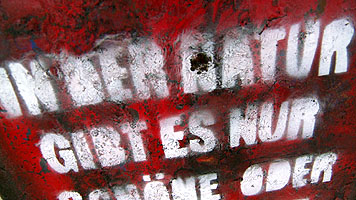


(Alex)Dirk Freyling independent researcher & artist



Wissen ist ein Privileg. Die Weitergabe eine Pflicht. Knowledge is a privilege. Sharing is a duty.
The nonexistent spin
of quarks and gluons
|
The
Quark Parton Model (QPM), developed by Richard Feynman in the 1960s, describes nucleons as the composition of basic
point-like components that Feynman partons called. These components
were then identified with the quarks, postulated by Gell-Mann and
Zweig at the same time a few years earlier. According to the
Quark-Parton Model, a deep inelastic scattering event (DIS deep
inelastic scattering) is to be understood as an incoherent
superposition of elastic lepton-particle scattering processes. A cascade of interaction conjectures, approximations,
corrections, and additional theoretical objects subsequently "refined"
the theoretical nucleon model. A fundamental (epistemological) problem is immediately
recognizable. All experimental setups, implementations, and
interpretations of deep elastic scattering are extremely theory based. Fundamental contradictions exist at the theoretical
basis of the Standard Model of particle physics, which, despite better
knowledge, are not corrected. An example: The nonexistent spin
of quarks and gluons A landmark, far-reaching wrong decision was made in
1988. The
first assumption was, due to the theoretical specifications of the
mid-1960s that in the image of the SM the postulated proton spin is
composed to 100% of the spin components of the quarks. This assumption
was not confirmed in 1988 in the EMC experiments. On the contrary,
much smaller, even zero-compatible components were measured (ΔΣ =
0.12 ± 0.17 European Muon Collaboration). Also the next assumption
that (postulated) gluons contribute to the proton spin did not yield
the desired result. In the third, current version of the theory,
quarks, gluons (...virtual Quark-anti-Quark pairs if one wishes too)
and ... their dynamical-relativistic orbital angular momentum generate
the proton spin. On
closer inspection, the second readjustment has the „putative
advantage” that the result in the context of lattice gauge
theory and constructs, such as "pion clouds",
algorithmically "calculated", can’t be falsified. But
this purely theoretical based construction obviously does not justify
the classification of quarks as fermions. No matter how the
asymmetrical ensemble of unobservable postulated theoretical objects
and interactions is advertised and will be advertised in the future,
the quarks themselves were never "measured" as spin-½
particles. Summary
in simple words: It is possible to create a theory-laden ensemble of
Quarks and “other” theory objects and their postulated
interactions, but the Quark itself - as an entity - has still no
intrinsic spin -½ in this composition. That means that Quarks
aren’t fermions, no matter what the actual theoretical approach
would be! This is a basic, pure analytical and logical statement. Generally
speaking: If one postulates a theoretical entity with an intrinsic
value but one discovers that one needs to add theoretical objects and
postulated interactions to get the desired intrinsic value, one has to
admit that ones entity has no physical characteristic as such. Further more: In sum, the quark masses postulated according to the SM
do not yield the nucleon masses by far. Gluons are massless. Postulated Up-Quark mass: 2.3 ± 0.7 ± 0.5 MeV / c²
up (u) Postulated down-quark mass: 4.8 ± 0.5 ± 0.3 MeV / c²
down (d) 938,272 0813 (58) MeV / c² Proton mass duu ~ 0,8 -
1,2% (!!!) Quark mass fraction 939,565 4133 (58) MeV / c² neutron mass ddu ~ 1,1 -
1,4% (!!!) Quark mass fraction Thus, also heavy ions composed of protons and neutrons
(such as lead or gold nuclei) can not be represented by quarks and
gluons. This means that according to the principle of mass-energy
equivalence, nucleons and, ultimately, heavy ions consist almost
entirely of phenomenologically indeterminate binding
energy. Even more complicated is the fact that the ions are
accelerated to almost the speed of light before they collide. This
means that there is also a considerable amount of external energy
added to the binding energy. Neither the theory of relativity neither
the SM does tell us how these phenomenologically can be divided into
translational energy and "mass equivalence." Protagonists of the SM are so convinced of their belief
that they have obviously lost sight of the essential. Why should a
postulated complex, multi-object-asymmetric, charge-fragmented,
dynamic substructure create a spin value ½ and an elementary charge
of exactly 1·e over
dynamic states in the temporal or statistical mean? The comparison
with the SM point-postulated, "leptonic" electron, with spin
value ½ and elementary charge 1·e, which are "created" without "dynamic effort"
and structure, identifies the quarks-gluon thesis as a fairy tale. The Quark Parton Model describes a complex theory situation and associated theory-laden (high-energy) experiments, the understanding of which is characterized by diverse aspects and a whole series of postulates. How the (here relatively simply described) nested theory-experiment-construct looks like, see representative the explanations (part 1 -3) of the Institute for Nuclear and Particle Physics Dresden. Part1 fails early on the interpretations of the presented model based on "theory-internal" assumptions. ... "This is remarkable, especially the neutron as an electrically neutral particle should have vanishing magnetic moment. This already indicates that protons and neutrons are not point-like, but have an internal structure..." Is the magnetic moment of the neutron really evidence for a substructure? Or is this assumption just a theory-laden measurement interpretation of the Standard Model? The interpretation of a neutron-quark (sub)structure loses its meaning if one examines the situation numerically (independent of the thought model). The supposedly anomalous magnetic moments of electron and proton as well as of the neutron are finally a combination of the "semi-classical" - most simply calculated - "normal" magnetic moments and measurement-inherent contributions, which originate from the magnetic field, which is used for the measurement. This qualitative statement can be concretized (in accordance with the measured values). See further the remarks on the neutron from the point of view of a mass-radius-coupled model, with which both the mass and the magnetic moment of the neutron can be calculated from the neutron-forming interaction of electron and proton in a phenomenologically understandable and exact way. The quark-parton model is an excellent teaching piece from the series of creeds (like once the epicycle or phlogiston theory). Experimental result interpretations led to some theoretical assumptions, which then quickly reach a substructured complexity by means of further interpretations with the help of new theory objects and postulated interactions, which finally eliminate any inappropriate experimental results by appropriate measures. First there were the postulated quarks. These required a fragmentation of the elementary electric charge. Then followed gluons, since quarks did not provide corresponding spin contributions of the nucleons. After that, so-called "sea quarks" were introduced as a supplement, since the postulated gluons also did not provide a corresponding spin contribution. Details of the "established" nucleon model see part 2 and part 3 (The Quark-Parton-Model) ... The analysis of the believers ends then with the belief finale... ... "The nucleon is therefore built up from valence quarks, sea quarks and gluons. But for the properties of the nucleon (and all hadrons) like charge, mass and spin only the composition of the valence quarks is responsible. Therefore one often speaks of constituent quarks and means the valence quarks plus the surrounding cloud of sea quarks and gluons. Sea quarks and gluons do not contribute to the (net) quantum numbers, but they do contribute to the mass of the hadron, since they carry energy and momentum. While the bare mass of the valence quarks is only a few MeV/c², the constituent quarks carry the respective fraction of the hadron mass, in the case of the nucleon thus about 300 MeV/c². This is thus predominantly contributed by the gluons and sea quarks. In other words, the vast majority of the hadron masses (and thus the visible mass in the universe) is not carried by the bare masses of the constituents, but is dynamically generated by the energy of the interaction!" Isn't that nice. There are clouds and naked and the God-analogous indeterminate, which is about 99%, given the postulated masses of the "matter-forming" quarks. But here the faith fairy tale is not really at an end. In a bigger picture (ΛCDM-model) it is now postulated that the visible mass is again only a small part of the mass in the universe. For the most part, for today's Standard Model believers, the universe consists of Dark Matter and Dark Energy. Dark stands here for not detectable. No miracle that the Vatican invites year after year highly delighted to the science prayer. That neither the preachers nor the people a light rises has Theodor Fontane so formulated: We are already deep in decadence. The sensational is valid and only one thing the crowd favours even more enthusiastically, the bare nonsense." |